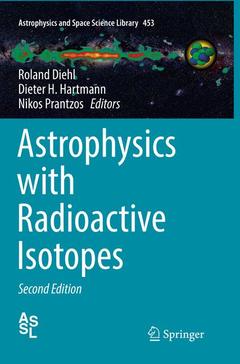Description
Astrophysics with Radioactive Isotopes (2nd Ed., Softcover reprint of the original 2nd ed. 2018)
Astrophysics and Space Science Library Series, Vol. 453
Coordinators: Diehl Roland, Hartmann Dieter H., Prantzos Nikos
Language: English
Subject for Astrophysics with Radioactive Isotopes:
Publication date: 02-2019
Support: Print on demand
Publication date: 10-2018
Support: Print on demand
Description
/li>Contents
/li>Biography
/li>Comment
/li>
Dealing with astrophysics derived from the radiation emitted by radioactive atomic nuclei, this book describes the different methods used to measure cosmic radio-isotopes. It demonstrates how this astronomical window has contributed to the understanding of the sources and the chemical evolution of cosmic gas. Reference materials and explanations are included for students in advanced stages of their education.
Nuclear reactions in different sites across the universe lead to the production of stable and unstable nuclei. Their abundances can be measured through different methods, allowing to study the various nuclear processes taking place in cosmic environments. Nucleosynthesis is the cosmic formation of new nuclear species, starting from hydrogen and helium resulting from the big bang origins. Stars create and eject synthesized nuclei during their evolution and explosions. Incorporation of the new interstellar composition into next-generation stars characterises the compositional (chemical) evolution of cosmic gas in and between galaxies. Radioactive species have unique messages about how this occurs.
Since the first Edition of this book published in 2011 with the title Astronomy with Radioactivities, long-awaited new direct observations of supernova radioactivity have been made and are now addressed in two updated chapters dealing with supernovae. In this second Edition, the advances of recent years beyond one-dimensional treatments of stellar structure and stellar explosions towards 3-dimensional models have been included, and led to significant re-writings in Chapters 3-5. The sections on the Solar System origins have been re-written to account for new insights into the evolution of giant molecular clouds. The chapter on diffuse radioactivities now also includes material measurements of radioactivities in the current solar system, and their interpretations for recent nucleosynthesis activity in our Galaxy. Significant new results on gamma-rays from positron annihilations have been accounted for in that chapter, and led to new links with nucleosynthesis sources as well as interstellar transport processes. A new chapter now provides a description of interstellar processes often called 'chemical evolution', thus linking the creation of new nuclei to their abundance observations in gas and stars. The experimental / instrumental chapters on nuclear reaction measurements, on gamma-ray telescopes, and pre-solar grain laboratories have been updated. Moreover, new windows of astronomy that have been opened up in recent years have been included in the discussions of the multi-messenger approach that broadens the basis for astrophysical insights.
Roland Diehl is research scientist at the Max Planck Institut für extraterrestrische Physik (MPE). He holds a doctoral degree in physics from the Technische Universität München (1988) and is Professor (apl.) in the Physics Department at the Technische Universität München. He started his career from nuclear physics, joining the staff of the gamma-ray astronomy group at MPE in 1979. Experimental nuclear physics determined his early work. This evolved into taking part in development of pioneering telescopes for the MeV regime of astronomy at MPE, specifically the COMPTEL telescope, which was operated 1991-2000 in space aboard NASA's Compton Gamma-Ray Observatory, and the SPI imaging spectrometer aboard ESA's INTEGRAL satellite observatory launched in 2002 and operating successfully since. After leading the calibrations of the COMPTEL telescope, he has been guiding different teams to advance analysis methods required for these complex measurements with gamma-ray telescopes, which involved telescope projects COMPTEL, INTEGRAL/SPI, GRIPS, and eAstrogam. He is Co-Principal Investigator of the INTEGRAL SPI telescope, and head of MPE’s science team on cosmic gamma-ray spectroscopy. He has been member of several international and national science advisory boards, and of the Senate of the Max-Planck Society. His astrophysical interest is centered on nuclear astrophysics, interpreting gamma-ray line measurements in their context of nucleosynthesis in stars and supernovae, and related cosmic ray physics. He pioneered the imaging of the sky in the radioactive-decay gamma-ray line from 26Al, and is currently involved in studies of supernovae, massive stars, novae, and how these energise and shape the interstellar medium, employing a broad range of astronomical measurements.
Dieter H. Hartmann is a Professor of Astrophysics on the faculty of the Department of Physics and Astronomy at Clemson University, South Carolina, USA. He holds a Ph.D. from the Universityo




